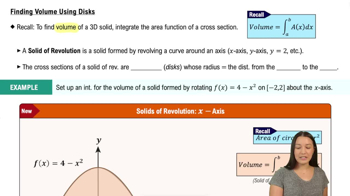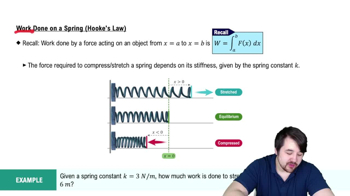A rope hangs freely over a ledge. The density of the rope is /. If a bucket is attached to the end of the rope, how much work is done to pull the rope and the bucket to the ledge?
Table of contents
- 0. Functions7h 54m
- Introduction to Functions16m
- Piecewise Functions10m
- Properties of Functions9m
- Common Functions1h 8m
- Transformations5m
- Combining Functions27m
- Exponent rules32m
- Exponential Functions28m
- Logarithmic Functions24m
- Properties of Logarithms36m
- Exponential & Logarithmic Equations35m
- Introduction to Trigonometric Functions38m
- Graphs of Trigonometric Functions44m
- Trigonometric Identities47m
- Inverse Trigonometric Functions48m
- 1. Limits and Continuity2h 2m
- 2. Intro to Derivatives1h 33m
- 3. Techniques of Differentiation3h 18m
- 4. Applications of Derivatives2h 38m
- 5. Graphical Applications of Derivatives6h 2m
- 6. Derivatives of Inverse, Exponential, & Logarithmic Functions2h 37m
- 7. Antiderivatives & Indefinite Integrals1h 26m
- 8. Definite Integrals4h 44m
- 9. Graphical Applications of Integrals2h 27m
- 10. Physics Applications of Integrals 3h 16m
- 11. Integrals of Inverse, Exponential, & Logarithmic Functions2h 34m
- 12. Techniques of Integration7h 41m
- 13. Intro to Differential Equations2h 55m
- 14. Sequences & Series5h 36m
- 15. Power Series2h 19m
- 16. Parametric Equations & Polar Coordinates7h 58m
10. Physics Applications of Integrals
Work
Problem 8.6.90
Textbook Question
90. Work Let R be the region in the first quadrant bounded by the curve y = √(x⁴ - 4)
and the lines y = 0 and y = 2. Suppose a tank that is full of water has the shape of a solid of revolution obtained by revolving region R about the y-axis. How much work is required to pump all the water to the top of the tank? Assume x and y are in meters.
 Verified step by step guidance
Verified step by step guidance1
Step 1: Understand the problem. The region R is bounded by the curve y = √(x⁴ - 4), the line y = 0, and y = 2. This region is revolved about the y-axis to form a solid of revolution. The goal is to calculate the work required to pump all the water to the top of the tank, assuming the tank is full of water.
Step 2: Express x in terms of y. Since the curve is given as y = √(x⁴ - 4), solve for x in terms of y: x = (y² + 4)^(1/4). This will help us describe the radius of the solid at any height y.
Step 3: Set up the volume of a thin disk. A thin horizontal slice of the solid at height y has a radius x = (y² + 4)^(1/4) and thickness dy. The volume of this slice is dV = π * [x(y)]² * dy = π * (y² + 4)^(1/2) * dy.
Step 4: Calculate the work for a thin slice. The weight of the water in the slice is its volume multiplied by the density of water (ρ = 1000 kg/m³) and gravity (g = 9.8 m/s²). The work to pump this slice to the top of the tank (2 meters above the base) is dW = ρ * g * dV * (2 - y). Substitute dV from Step 3 into this expression.
Step 5: Integrate to find the total work. Integrate dW over the bounds of y from 0 to 2: W = ∫[0 to 2] ρ * g * π * (y² + 4)^(1/2) * (2 - y) dy. Simplify the integrand and compute the integral to find the total work required.
 Verified video answer for a similar problem:
Verified video answer for a similar problem:This video solution was recommended by our tutors as helpful for the problem above
Video duration:
12mPlay a video:
Was this helpful?
Key Concepts
Here are the essential concepts you must grasp in order to answer the question correctly.
Solid of Revolution
A solid of revolution is a three-dimensional shape created by rotating a two-dimensional area around an axis. In this problem, the region R is revolved around the y-axis, forming a tank. Understanding how to visualize and calculate the volume of such solids is crucial for determining the work needed to pump water from them.
Recommended video:

Finding Volume Using Disks
Work Done Against Gravity
Work is defined as the force applied over a distance. In this context, the work required to pump water to the top of the tank involves calculating the gravitational force acting on the water and the distance each volume of water must be lifted. This requires integrating the product of the weight of the water and the height it needs to be raised.
Recommended video:

Work Done On A Spring (Hooke's Law)
Integration in Calculus
Integration is a fundamental concept in calculus used to find areas, volumes, and other quantities that accumulate over a range. In this problem, integration will be used to sum the infinitesimal amounts of work done to lift each differential volume of water from the tank to the top. Understanding how to set up and evaluate these integrals is essential for solving the problem.
Recommended video:

Fundamental Theorem of Calculus Part 1

 6:22m
6:22mWatch next
Master Introduction To Work with a bite sized video explanation from Patrick
Start learningRelated Videos
Related Practice
Multiple Choice
92
views
